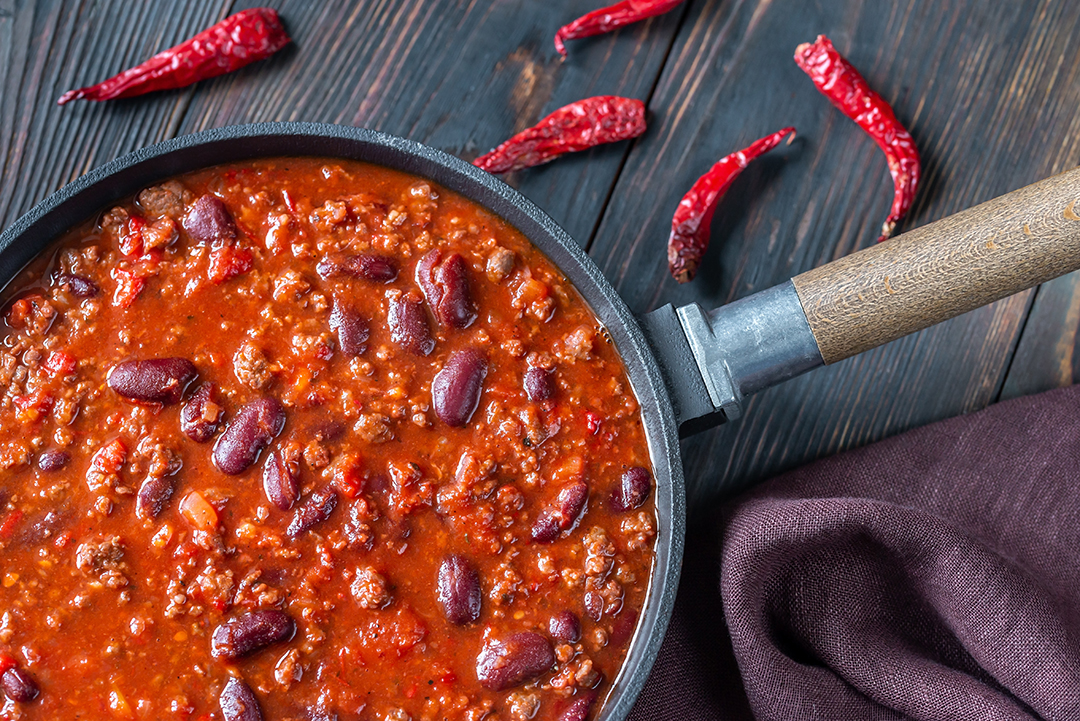Comfort Food for Troubled Times – Chili Con Carne

‘But I blamed well know one thing which should NOT go into it – and that is beans, single or plural.’
Homer Garrison Jr. Texas Department of Public Safety
‘With or without beans? What a question, indeed! Give thanks for chili, and ask a new blessing for every single bean.’
J.Q. Mahaffey, Editor, Texarkana Texas Gazette
We would often stop for a bowl of chili on the way from skiing. Nothing beat that inexpensive bowl of warmth that we would load up with crackers and ketchup.
I enjoyed chili because it was filling and warmed the spirit. I was unaware that so many books had been written about this bowl of red – and that debates raged about whether chili was true chili if it had beans, or even if chili could be made by anyone outside of the state of Texas.
Debates like this can be set aside for this recipe. Use ground meat, cubed meat, or no meat at all. Add beans or leave out the tomatoes. To me, the true mark of a good chili is the type of chilies that you use in the preparation of the dish.
Most cooks will build their chili using a commercial powder and ground cumin. This is fine – by adjusting the amounts of chili powder and ground cumin to taste you will end up with a very satisfying meal. However, there is so much more you can by making your own chili powder, which is why I include some ideas below. Your own chili powder will add your unique signature to this dish.
Also included is my recipe for corn bread – a perfect side dish for any bowl of red.
Chili con Carne
Feeds four – or two with leftovers.
Favorite Wine Pairing – Zinfandel
Ingredients
- 1 ½ pounds coarsely ground beef chuck (or mix of beef and pork)
- 1 onion, chopped
- 2 cloves garlic, minced
- 2 teaspoons oregano, dried
- 1 teaspoon cumin, ground (adjust upwards for your taste)
- 2 tablespoons chili powder
- 1 (~15-ounce) can diced tomatoes with juice
- 2 cans pinto beans (or mix of pinto and kidney), drained
- 1 – 2 bay leaves, removed before serving
- Salt (to taste)
- Hot sauce (to taste – depending on the chili powder)
Directions
In a Dutch oven or soup pot, sauté the onions with a pinch of salt until translucent. Add the ground meats, garlic, and spices. When the meat begins to gray (don’t brown), add in the tomatoes and beans and bring to a simmer. Lower heat and cook covered for half an hour stirring every ten minutes. If the chili becomes too dry, stir in a bit of water while cooking. If it is too runny, then add a bit of corn starch to thicken at the end. Adjust seasoning again towards the end of the cooking time.
Chili is good hot, with toppings of crackers, cheese, and even sour cream. But, remember, chili can be even better the next day rewarmed.
Corn Bread
Ingredients
- 1 ¾ Cups all-purpose four
- 1 Cup cornmeal
- ¼ Cup sugar
- 2 teaspoons baking powder
- ¼ teaspoon baking soda
- ½ teaspoon salt (to taste)
- 1 ¼ Cups milk
- 4 tablespoons butter, melted
- ¼ Cup vegetable oil
- 1 large egg
Directions
Set oven to 375. While oven is warming, mix the dry ingredients in a bowl. In a separate bowl, whisk the egg and then add the milk, oil, and melted butter whisking as you go. Pour the custard into the dry ingredients all at once and stir gently to combine. Stir just until the batter comes together – this gives the cornbread a lighter texture.
Pour the batter into a lightly greased baking pan or shallow casserole dish. Bake for 25 minutes until the edges begin to pull away from the pan and a toothpick comes out clean.
Remove from the oven and let cool a few minutes to set. Serve warm with a bowl of your homemade chili.
Notes on chili powder
I buy dried chilies when I find them at farmers markets, or I order them in small bags from suppliers. I take what I need for my batch of powder and store the rest in airtight cannisters. Because they are dried, they have a long shelf life.
There are many types of chilies you can use, depending on whether you like smoky, spicy hot, or both. You can also create mild yet flavorful chilies. Here are a few of the types I use with some notes about them.
Ancho – a dried poblano pepper that is mild and fruity. I use a few of these each time to form the base of my flavors.
Pasilla – a dried form of the chilaca pepper – rich and earthy with a hint of raisin that imparts a little sweetness with slight notes of smoky cocoa.
Guajillo – dried form of the mirasol chili – fruity undertones with maybe a hint of cranberry.
The above three chilies, often called the ‘Holy Trinity’ of Mexican dried chilies, form the base of my chili powders. To this base, I often will add:
Chipotle – the dried and smoked form of jalapeno, which adds mild heat and smoke flavors to the powder. I use these sparingly.
Arbol – adds heat – a step above jalapeno in the 15,000 – 30,000 Scoville range.
To make my chili powder, I quickly heat the whole chilies in a pan to bring out their perfume (don’t burn them). When cooled, I remove the stems. Then, using scissors, I open the pepper and remove the seeds and pith. I grind my mixture of peppers in a blender until they form a course powder. The powder can be stored in an airtight container like you would for any commercial powder.


